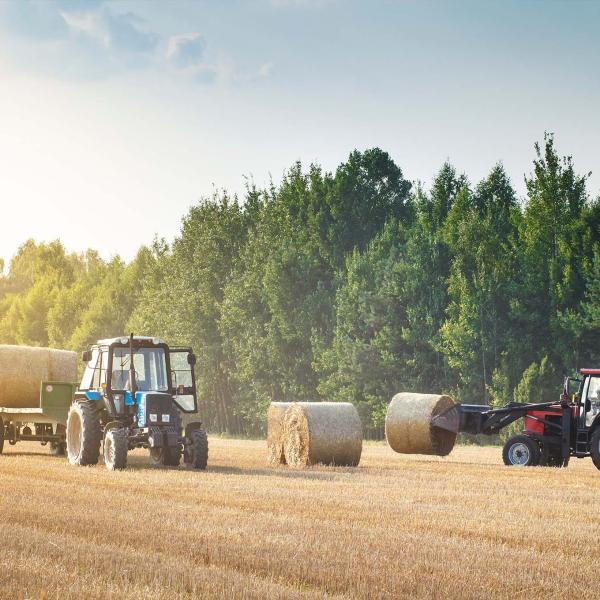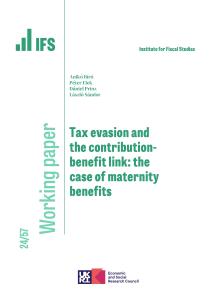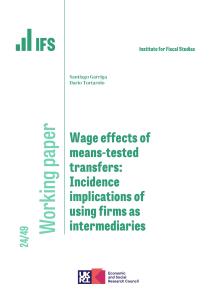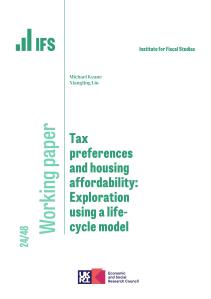The Budget announced a range of changes to inheritance tax, curtailing reliefs for agricultural and business assets, bringing pensions into the scope of inheritance tax and freezing tax-free allowances until 2029–30. Together, the changes are expected to raise around £2.3 billion per year by 2029–30, £520 million of which comes from reducing business and agricultural reliefs.
While accounting for only a small part of the higher inheritance tax revenue, the changes to agricultural and business reliefs and specifically their effects on farms and farmers have received significant attention. What are the changes? Who will be affected? And are these measures a good idea?
How is inheritance tax for farms and businesses changing?
Currently, full relief from inheritance tax is available for most agricultural property and business assets held for two years before death. In the case of agricultural property, relief applies in full to property held for more than two years, if farmed by the owner, but for property rented out the minimum holding period to get inheritance tax relief is seven years. HMRC recorded that, in 2021–22, 1,730 estates claimed agricultural relief, and £550 million of inheritance tax was relieved under agricultural relief, an average tax saving of over £300,000 per estate (with some benefiting from business relief on top of this). The largest 117 claims (7% of claims) accounted for 40% of the total value of agricultural relief (£219 million) and just 37 (2%) accounted for 22% of the total value (£119 million, or £3.2 million each).
The Budget announced that, from April 2026, business and agricultural reliefs will be restricted. Estates will be eligible for 100% inheritance tax relief on the first £1 million of combined business and agricultural assets and 50% relief on amounts over £1 million (i.e. 40% tax will apply to only 50% of the value of business and agricultural property in excess of £1 million). Shares designated as ‘not listed’ (notably AIM shares) will in all circumstances receive only 50% relief, i.e. they are not covered by the £1 million of 100% relief.
The 100% and 50% reliefs are in addition to the nil-rate band, which allows £325,000 of assets to be passed on free of inheritance tax, and the residence nil-rate band which allows a further £175,000 to be passed on if bequeathing a home to a direct descendant. This means that, in many cases, an individual could pass on £1.5 million free of tax and a couple could pass on £3 million free of tax. To take an example, consider a married couple with a farm worth £3 million, including a family home worth at least £350,000. The couple could pass on their wealth as follows:
- The first member of the couple to die passes on a £1 million share of the farm tax-free to their children using the new £1 million allowance. They leave any remaining assets to their spouse (which is always tax-free), who also inherits their unused nil-rate band and residence nil-rate band.
- The second member of the couple to die passes on the remaining £2 million, including the home, to their children tax-free. £1 million is covered by the new allowance, and the other £1 million is covered by the combination of their own nil-rate band and residence nil-rate band and those they inherited from their spouse.
Couples will not always be able to pass on this much tax-free, but often they will be able to pass on even more, and in certain (unusual) circumstances it will be possible for couples to pass on as much as £4 million combined before any inheritance tax is paid. With large amounts bequeathable tax-free, where tax is payable it will often only be a small percentage of the total value of the estate. The inheritance tax liabilities will be heavily concentrated on the very largest estates.
Inheritance tax due on business and agricultural property will be able to be spread over a 10-year period interest-free.
While the reform scales back business and agricultural reliefs, it is far from removing them completely: the government estimates that the change will raise £520 million a year but still leave these reliefs costing £1.8 billion a year.
How many farms will be affected?
Based on HMRC tax data, the government forecasts that out of the 1,800 estates per year claiming agricultural relief (including those which claim business relief as well), around 500 – 29% – could potentially pay more inheritance tax as a result of curtailing agricultural and business reliefs. However, these figures do not account for any change in behaviour that happens as a result of the Budget policy measures. The number of farming estates actually paying more tax due to the Budget policies could be much lower than 500 per year if, in response to these changes, some people change their behaviour to avoid inheritance tax. That might happen if, for example, more farm-owning couples split the transfer of assets to the next generation across their two estates (to take full advantage of both spouses’ allowances), or if there is increased gifting of assets more than seven years before death.
There has been public exchange of figures on the proportion of farms that will be affected by the tax changes. The National Farmers’ Union has claimed, citing figures from the Department for Environment, Food and Rural Affairs (Defra), that around two-thirds of farms are worth over £1 million and are therefore potentially affected by the Budget measures. It is claimed that this contradicts the government figures above showing that 29% of estates claiming agricultural relief could face higher tax because of the Budget measures.
These two figures measure two different things and there are many reasons the two proportions being cited could differ without this implying that either is incorrect. The government figures based on inheritance tax returns reported to HMRC relate to all estates claiming agricultural relief, while the Defra figures from the Farm Business Survey relate to farms with at least a minimum level of output. One reason the two proportions could differ is that some estates claiming agricultural relief may do so on property that is not producing enough output to be included in Defra’s Farm Business Survey. A second reason for differences is that one estate could include only a share of a farm and/or could include multiple farms. A third reason is that some farms will be gifted well before death and therefore not attract inheritance tax. There may be other reasons for differences too. The share of ‘farms’ or ‘farmers’ affected by the Budget measures depends on how exactly terms are defined.
Will farms have to be sold?
However defined – and therefore whatever the proportions – it is clear that some farms will be able to be passed on tax-free, while others will attract inheritance tax. Those farm owners who do not have a (surviving) spouse or civil partner, or who face a higher chance of dying within seven years, have less ability to manage their affairs so as not to pay inheritance tax.
Where inheritance tax is due, will it lead to farms’ being sold?
As noted above, the tax can be spread over 10 years interest-free. And in principle, the burden of the tax can be spread over longer than 10 years by saving up beforehand or by borrowing (perhaps with the farm as collateral) to pay the tax and paying back the loan more gradually.
Nevertheless, in some cases the farm will simply yield too little income (and the inheritor will have too few other resources) to pay the tax. The owners might choose, or be forced, to sell part or all of the farm. This is a feature of inheritance tax: the same applies to those inheriting a family home, for example.
But it matters when and why farmland is sold and what happens when it is sold. To understand that, it is worth reflecting on why a farm that yields little income might have a high enough market value to attract inheritance tax.
There are several possible (not mutually exclusive) reasons.
One is that the market price of farmland has been pushed up by demand to buy it as a vehicle to avoid inheritance tax. By reducing (though not eliminating) the tax advantages of agricultural property, the Budget reform should reduce its price – softening the inheritance tax hit and the impetus to sell farms, and indeed making farmland more affordable for those who want to buy it for non-tax reasons. That is, the reform will make it easier to get into farming.
A second possibility is that land that currently yields little income has a high market value because potential buyers think they could use the land more profitably – whether by farming more efficiently or by using it for other purposes, such as housing development. Other things equal, reallocation of land for more profitable use should be welcomed. If other things are not equal, and the government wants land to be used in certain ways rather than others – for food security or environmental reasons, for example – then it should directly support the desired activities, making them more financially viable irrespective of inheritance tax.
A third possibility is that the land is already being used as productively as allowed, and the high market value reflects the speculative hope that planning permission might be granted in future for more profitable uses (such as housing development) which are not currently allowed. Pending such permission, continuing the current use of the land might be the most efficient outcome, yet not yield the income needed to cover any inheritance tax liability when it is bequeathed. In such cases, the farm might be sold (in part or whole) but still used for farming – indeed, the existing owners could potentially stay on as tenant farmers.
Should farms be subject to inheritance tax?
There is room for reasonable disagreement about whether we should have an inheritance tax at all. But if we have this tax, it should apply equally across all types of assets. Inheritance tax relief for agricultural and business assets unfairly favours those whose wealth is held in these forms rather than others: those who inherit a (multi-)million-pound farm are wealthy, even if the farm yields little income and they choose not to monetise the asset (around 3% of all estates requiring probate or confirmation have a net estate worth more than £1.5 million, and around 1% of estates requiring probate or confirmation have a net estate worth more than £3 million). And the relief provides a tax incentive for land to be used for agriculture (rather than more profitable but less tax-privileged purposes) and for agricultural property to be owned by those looking to pass on wealth to their heirs tax-efficiently (rather than those who value ownership for other reasons). The changes set out in the Budget reduce but do not eliminate these effects.
If the government wishes to promote certain uses of land – such as producing food, planting trees or encouraging biodiversity – it would be fairer and more efficient to explicitly target support towards the activities it seeks to promote. This would support any farm or business carrying out the desired activity, not only those that are passed on in estates (and not those used for other things), and would not leave open a channel for inheritance tax avoidance. Likewise, if the government wishes to redistribute to certain groups in society, it should do so directly: inheritance tax relief is not a well-targeted tool for doing these things. The government should clearly set out whether it has such aims and its view on the type and level of support required to achieve them.
As with all tax changes, the exact design of the policy and the transition to the new regime are important.
As discussed above, a typical couple might expect to be able to use both of their £1 million allowances. But people will not inherit any unused part of the £1 million allowance from a deceased spouse or civil partner, like they do with the nil-rate band and residence nil-rate band. So, to use both partners’ allowances, each must separately bequeath at least £1 million of the property to others (e.g. children). That means splitting ownership of the property between family members on or before the death of the first partner, rather than bequeathing the whole thing when one of them dies. It will also disadvantage families where one member of the couple has already passed away. There is a good case for making unused portions of the £1 million allowance inheritable by a spouse or civil partner. This would clearly reduce the revenue raised by the policy (and, as with the existing transferability of nil-rate bands, would not help couples who are not married or in a civil partnership).
Gifts made more than seven years before death are not subject to inheritance tax. Yet current farm owners passing away in the next seven years (but after the new regime comes into force in April 2026) will not have had that opportunity to avoid inheritance tax by making lifetime gifts. If the government wished to give current farm (or business) owners the same opportunity to avoid inheritance tax that owners of other assets have, it could do so by transitioning to the new regime more slowly. For example, lifetime gifts of agricultural property made before a certain future date could be made inheritance tax free, regardless of the timing of the death of the giver, so that those farm owners who pass away in the next seven years have an opportunity to make tax-avoiding gifts in light of the Budget changes. This would reduce the revenue raised from the policy, but this would be one-off, rather than permanent, reduction in the revenue raised.
Conclusion
The reforms to taxation of agricultural property proposed in the Budget would reduce the inheritance tax advantages enjoyed by owners of farmland but would still leave that land much more lightly taxed than most other assets. The exact number that will be affected is uncertain but government figures imply it will be significantly less than 500 estates per year. Some relatively simple tax planning will ensure that many farms worth considerably more than £2 million will not be liable for tax. And it is important to remember that most of the inheritance tax payable will be on very valuable estates. Overall, this moves our inheritance tax in the right direction. We should treat similar assets similarly for the purposes of inheritance tax, or any other tax, unless there are very good reasons not to. It is not obvious that such reasons exist in this case, and if the concern is about food production or protection of the environment then much better tools exist to support those activities.
It is not surprising that those who might lose from any tax change will feel aggrieved. That is their right and to be expected. One specific feature that may leave farm owners feeling unfairly treated is that those passing away in the next seven years (but after the new regime comes into force in April 2026) will not have had the opportunity to avoid inheritance tax by making lifetime gifts. If the government wished to give current farm owners the same opportunity to avoid inheritance tax as owners of other assets, it could, for example, make lifetime gifts of agricultural property made before a certain future date inheritance tax free, regardless of the timing of the death.
Whether or not the government wishes to make that tweak to the policy, there is certainly a good case for making unused portions of the £1 million allowance inheritable by a spouse or civil partner, like the other main inheritance tax allowances are.












